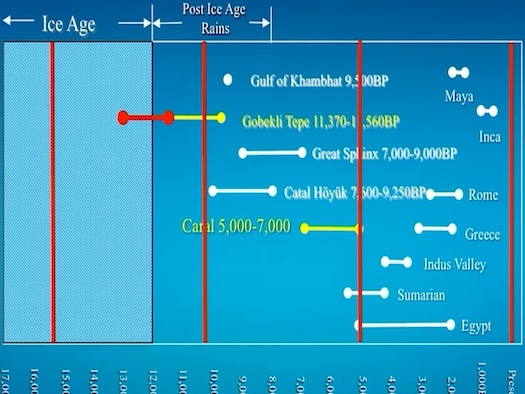
Ancient civilizations go way further back than official accounts given to us by mainstream academia. A growing number of academics know this. Some may fear ridicule as a backlash for their mistakes and many don’t want to go through the painstaking work of re-writing the text books.
However, mainstream archaeologists are now starting to open up to the possibility of a wider timeline while making new findings, confirming that ancient civilizations are older than 5,000 years.
For example, the findings of a site at Caral, North Peru. Caral has taken the archeology world by storm. Supporting evidence backs up the claim that it is the oldest, most technologically advanced civilization in the Americas.
This makes it older than anything else found in the Americas: This includes, the Aztec, Olmec, Inca, and the Toltec… Older than anything found in Mexico or North America.
It has been said that, with its advanced civilization, Caral ended 5,000 years ago. However, it had flourished some 2,000 years before. Therefore, this tribal site goes as far back as 7,000 years!
-This is not the only case where the evidence does not give support to official history, that ancient civilizations began 5,000 years ago. In other words, it’s not a mere anomaly that can be ignored in the collective data: There are many other anomalies, world-wide.
Caral was roughly a 150-ace terrain. This large terrain included 5 pyramids, several circular plazas.
One of its fascinating and unusual aspects is that it has stones inscribed as images rather than written word form. Archeologists have deciphered some of these symbolic images and claim that the civilization that lived there had knowledge of astronomy, as they were able to tell where celestial bodies existed in the cosmos and how Earth stood in relation.
-These astronomical relationships of the cosmos weren’t discovered until the 20th century in the Western-World! How could the natives of Caral work this out during those ancient times?!

The Great Pyramid and the Sphinx
Another anomaly is the Great Pyramid that stands on the Giza Plateau, Egypt. This has been steeped in controversy over the years over its age and origins.
At this location, one of the many challenges to mainstream archeology and historians is the age of the sphinx.
Boston university researcher Robert Schoch claims that the erosion patterns on the sphinx were made by rapid-moving high-water levels which could only have been brought about by melting ice that had occurred just after the last ice age.
-This therefore dates the sphinx as far back as around 12,000 years ago. Remember, the sphinx would have to have been built before this time in order to have incurred these high-water fluvial erosion marks.
The sphinx couldn’t have been placed at this location at a different date because the evidence confirms that it was carved out of stone from the ground matrix rock at the Giza Plateau.
Göbekli Type
Another one of a number of advanced ancient civilizations, agreed upon by scientists that goes further back than 5,000 years, is Göbekli Tepe
Some pottery had been found at this site and the evidence showed it was much older than 5,000 years.
This opened up further enquiries: In the 1990’s archaeologist Klaus Schmidt, not confined to the closed-mindedness of academia’s official line, that advanced civilization was only 5,000 years old, he spent the rest of his life excavating the remains at this site.
Göbekli Tepe is shrouded in mystery. It has been said that it comprises a collection of underground temples. Earth imaging radar technologies have been used to identify the underground buried structures with some amazing hieroglyphs and circular temples. No one really knows what they were doing there. -Why had they been buried?
Research on some of the hieroglyphs reveals that the indigenous people that lived there understood the orientation of constellations and star systems. These constellations and star systems weren’t discovered until the 20th century in the Western-World!
It’s very curious that amongst the artifacts there are a number of human figures, but there aren’t any with a mouth in their design. Why? -Does this have some significance?
It gets more fascinating. This site was deliberately buried around 8,000 years ago. However, more research reveals that this dating goes even further back in time to well over 11,000 years! More excavation reveals a possible timeline that could be as late as 13,000 years ago, the time of the last ice age.
Gulf of Khumbhat
Another fascinating discovery is the Gulf of Khumbhat, which lies north of Mumbai and Diu Island, India.
The evidence suggests that it had not been intentionally built underwater. It was built at its location when there was just land. It has been said water arrived later which then submerged the area. The difficulty that mainstream archeology and history has with this is that they have to accept that the submergence was caused by the melting water from the receding last ice age (rising sea levels).
-That therefore dates this as one of the advanced ancient civilizations to go as far back as 12,000 years ago.
The Gulf of Khumbhat is a huge site, stretching some 5 miles long by 3 miles wide. Its size and that it’s underwater submerged makes excavation rather tricky and time consuming.
Finally
Referring to the above image of this article, you will see the timelines to the aforementioned advanced ancient civilizations.
The vertical red lines marks the 5,000-year increments over the time periods from the ice-age (far left) to the present day (far right). Clearly it shows that mainstream academia (archeology/history) has not got it right, that ancient civilizations only go as far back as 5,000 years.
Did these civilizations leave clues for us, preserved in their remaining artifacts; messages of advanced knowledge, wisdom relating to our ancestry? Many researchers think so. What about the missing links?
Evidence must always beat dogma.
Will we be seeing the end of one and the beginning of another 5,000-year cycle?
